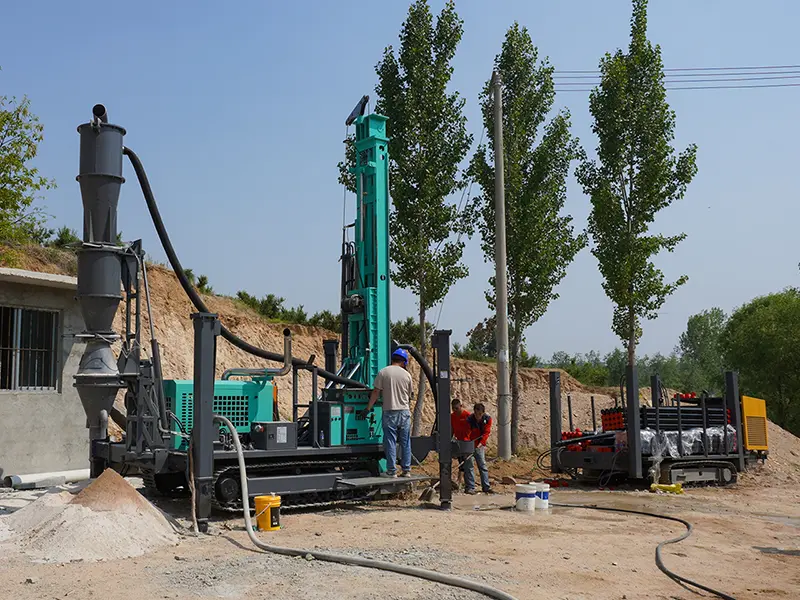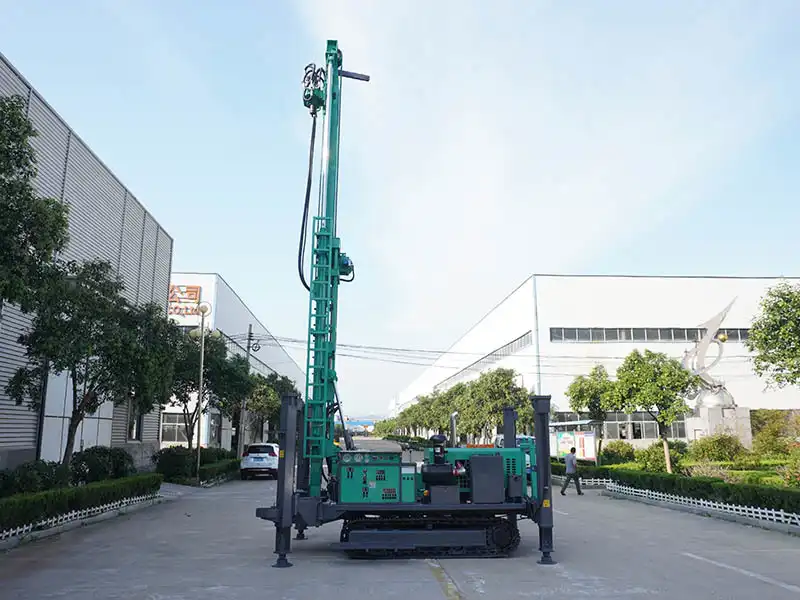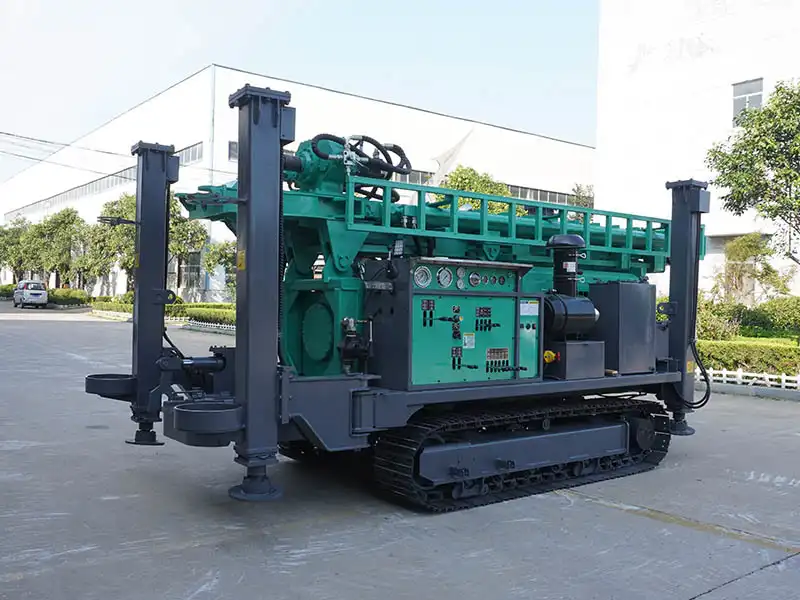
Die wirksamste Wasserbrunnenbohrung Methode hängt von den geologischen Bedingungen, den Tiefenanforderungen, der Wasserverfügbarkeit und dem Budget ab. Für flache Bohrungen (<100m) in weichen Formationen, Kabelwerkzeug-Bohrung bietet Einfachheit und niedrige Kosten. Für tiefere Brunnen (100m-800m), insbesondere in wasserarmen oder komplexen geologischen Verhältnissen, Drehbohren mit Schaumsystemen oder AI-optimierte Rotationsverfahren überragende Effizienz, Präzision und Erfolgsquoten bieten. Aufstrebende Technologien wie autonome Geolenkung und nano-verstärkte Bohrspülungen definieren die Effektivität neu, indem sie die Produktivität maximieren und gleichzeitig die Umweltbelastung minimieren.
Kernbohrungsmethoden: Techniken und Anwendungen
Kabelwerkzeug (Perkussion) Bohren:
Prozess: Hebt und senkt wiederholt einen schweren Meißel, um Gestein zu brechen. Entfernt das Bohrklein mit einer Schöpfkelle.
Am besten für: Flache Brunnen (<100 m), ländliche Gebiete mit begrenztem Budget und grobkörnige Sedimente.
Profis: Geringe Gerätekosten, einfacher Betrieb, minimaler Wasserbedarf, genaue Formationsprobenahme.
Nachteile: Sehr langsam in hartem Gestein, begrenzte Tiefe, arbeitsintensiv. Einst vorherrschend, ist sie heute für tiefere oder härtere Formationen, in denen Geschwindigkeit und Effizienz entscheidend sind, weitgehend verdrängt worden.
Drehbohrungen (direkte und umgekehrte Zirkulation):
Prozess: Ein rotierender Meißel schneidet Gestein. Direkte Zirkulation (DC): Die gepumpte Bohrspülung (Spülung/Wasser) fließt durch das Bohrgestänge nach unten und befördert das Bohrklein durch den Ringraum nach oben. Umgekehrter Kreislauf (RC): Die Flüssigkeit fließt durch den Ringraum und das Bohrklein wird durch das Bohrgestänge nach oben abgesaugt.
Am besten für: Die meisten modernen Wasserbrunnen (100 m - 600 m+), Brunnen mit größerem Durchmesser, unterschiedliche Geologie (Sand, Ton, mittelhartes Gestein). RC eignet sich besonders gut für große Durchmesser und unverfestigte Formationen.
Profis: Schnelleres Eindringen als ein Kabelwerkzeug, bewältigt unterschiedliche Formationen, gute Bohrlochstabilität bei angemessener Spülungskontrolle.
Nachteile: Erfordert erhebliche Wasser-/Schlammmengen, komplexe Einrichtung/Betrieb, Entsorgung von Bohrspülungen erforderlich.
Schaumbohren (Erweiterte Rotationsvariante):
Prozess: Mit Hilfe von Druckluft, die mit Wasser und Tensiden (Schaumbildnern) eingeblasen wird, wird eine Bohrspülung mit geringer Dichte und hohem Fassungsvermögen erzeugt.
Am besten für: Tiefbrunnen (500m-800m) in trockenheitsgefährdeten oder wasserarmen Regionenin zerklüfteten Formationen oder dort, wo eine Beschädigung der Formation durch Schlamm zu befürchten ist. Bewährt in trockenen Regionen wie Zentral-Yunnan (China) für Notbrunnen zur Wasserversorgung.
Profis: Drastische Wasserreduzierung (60-80% weniger als Spülungsrotation), ausgezeichnete Bohrlochreinigung in trockenen/gebrochenen Zonen, minimiert Formationsschäden, schnelleres Eindringen in geeigneter Geologie.
Nachteile: Erfordert spezielle Luftkompressoren/Schaumgeneratoren, komplexere Druckregelung, potenziell höhere Anschaffungskosten.
DTH-Hammerbohren (Down-the-Hole):
Prozess: Ein pneumatischer (oder manchmal auch hydraulischer) Hammer direkt hinter dem Meißel führt schnelle Schläge aus, während sich der Bohrstrang dreht. Verwendet Druckluft (oft mit Schaum/Nebel) zur Entfernung des Bohrkleins.
Am besten für: Harte Gesteinsformationen (Granit, Basalt), tiefe Bohrlöcher in kompetentem Gestein.
Profis: Schnellste Methode in hartem Gestein, gute Geradheit des Bohrlochs, relativ einfache Entfernung des Bohrkleins mit Luft.
Nachteile: Hoher Energie-/Druckluftbedarf, begrenzte Einsatzmöglichkeiten in nicht verfestigten Formationen ohne Verrohrung, Lärm/Vibrationen.
Vergleich der Brunnenbohrmethoden
| Methode | Optimale Tiefe | Beste Geologie | Geschwindigkeit | Bedarf an Wasser | Hauptvorteil |
|---|---|---|---|---|---|
| Kabelwerkzeug (Perkussion) | < 100m | Weiche Sedimente, Schotter | Langsam | Niedrig | Geringe Kosten, einfache Bedienung |
| Drehendes Bohren (DC/RC) | 100m - 600m+ | Sand, Ton, mittleres Gestein | Mäßig-schnell | Hoch | Vielseitig, für die meisten Formationen geeignet |
| Schaumstoff-Bohren | 500m - 800m | Gebrochenes Gestein, trockene Zonen | Mäßig-schnell | Sehr niedrig | Wassereffizient, Tiefbrunnenfähigkeit |
| DTH-Hammer | 50m - 500m+ | Harter Rock | Schnell (Rock) | Gering-Mäßig | Dringt effizient in hartes Gestein ein |
| AI-optimiertes Rotieren | Beliebige Tiefe | Komplex/heterogen | Schnellste | Variiert | Maximiert Präzision und Ertrag |
Kritische Faktoren zur Bestimmung der "wirksamsten" Methode
Geologie und Hydrologie: Unverfestigte Sande/Kiese benötigen oft Dreh- oder RC-Schlamm für die Stabilität. Zerklüftetes Grundgestein oder "rote Schicht"-Formationen profitieren von Schaum oder Luftnebel zur Beseitigung von Einschnitten und zum Auffinden von wasserführenden Klüften. Hartes Eruptivgestein oder metamorphes Gestein erfordert DTH-Hämmer. Tiefe, heterogene Becken gewinnen immensen Wert durch KI-gesteuertes Drehen Systeme.
Anforderungen an Tiefe und Durchmesser: Flache Schächte mit kleinem Durchmesser eignen sich für Kabelgeräte. Ergiebige kommunale oder landwirtschaftliche Brunnen (tief/großer Durchmesser) erfordern Rotations- (RC oft am besten) oder Schaumsysteme mit hoher Kapazität.
Wasserverfügbarkeit und Umweltauflagen: Schaumbohrungen sind in trockenen Regionen von entscheidender Bedeutung... mit minimalem Wasserverbrauch. Strenge Umweltvorschriften verlangen nach biologisch abbaubaren Flüssigkeiten mit geringer Toxizität (wie moderne WBM mit Esterschmierstoffen). Die Kosten für die Schlammentsorgung erhöhen die Kosten für Rotationsverfahren erheblich.
Budget und Zeitplan: Das Kabelwerkzeug hat die niedrigsten Anschaffungskosten für flache Bohrlöcher. Für tiefere Bohrlöcher, Rotationsverfahren bieten langfristig einen besseren Wert trotz höherer Anfangsinvestitionen aufgrund einer schnelleren Fertigstellung und eines geringeren Risikos. KI-Optimierung reduziert kostspielige Trockenbohrungen oder ertragsarme Bohrungen drastisch.
Brunnenzweck und Ertragsanforderungen: Ertragreiche kommunale Brunnen und Bewässerungsbrunnen erfordern Präzision bei der Suche nach produktiven Grundwasserleitern. AI-Geosteering und Schaum/RC für eine saubere Formationsbewertung zeichnen sich hier aus. Hausbrunnen mit geringer Ausbeute bieten mehr Flexibilität.
Aufkommende Technologien definieren die Effektivität neu
KI-gestützte Geolenkung und autonomes Bohren (z. B. Neuro™ von SLB): Nutzt Echtzeit-Bohrlochdaten und KI, um den Bohrer selbstständig zu steuern innerhalb der produktivsten Grundwasserleiterschicht. Vorteile: Schnellere Bohrungen mit höherer Ausbeute (z. B. 25 autonome Korrekturen in einer Bohrung in Ecuador), weniger "gewundene" Bohrpfade, die das Drehmoment/den Luftwiderstand senken, und weniger menschliche Fehler. Es verwandelt Standard-Drehbohrungen in die präziseste Option für komplexe geologische Verhältnisse.
Fortschrittliche nano-verstärkte Bohrspülungen: Graphen-Nanopartikel oder Ester (wie PC60) als Zusatzstoffe in Schlämme auf Wasserbasis (WBM) deutlich Verbesserung der Schmierung und Verringerung der Reibung (Annäherung an die Leistung von Schlamm auf Ölbasis). Vorteile: Erfüllt die Umweltvorschriften, reduziert das Risiko von Drehmoment, Verzug und festsitzenden Rohren, verbessert den ROP und stabilisiert Bohrlöcher in heißen Formationen. Entscheidend für effizientes Tief- oder Richtungsbohren.
Surrogatmodell-optimierte Wasserwirtschaft: Auch wenn der Schwerpunkt auf der Einspritzung von Öl liegt, gilt das Prinzip auch für die Auffüllung. AI verwendet schnelle Surrogatmodelle an komplexen Simulationen geschult, um Optimierung der Injektionszyklen, der Injektionsraten und der Platzierung der Brunnen für eine nachhaltige Bewirtschaftung der Grundwasserleiter. Verhindert Überfischung und maximiert den langfristigen Ertrag.
Wirtschaftliche Optimierung: Kosten vs. Effektivität
Effektivität ist nicht nur eine technische Leistung; sie ist wirtschaftliche Lebensfähigkeit. Zu den wichtigsten Strategien gehören:
"One-Pass"-Bohrungen und optimales Gehäusedesign: Verwendung von größere ursprüngliche Lochgrößen und Reduzierung unnötiger Darmstränge (z. B. "One-Size"-Ansatz, wo immer möglich) senkt die Zeit- und Materialkosten.
Überlegenes Schlamm-Management: Investieren in effiziente Feststoffkontrollsysteme (Schieferschüttler, Entsander, Zentrifugen) reinigt und recycelt Bohrflüssigkeit, Senkung der Abfallbeseitigungskosten und Verbesserung der Durchdringungsrate.
Datengestützte Prozessoptimierung: Durch die Analyse von mehr als 100 Leistungskennzahlen für Bohrungen (Bohreffizienz pro Formation, Werkzeugstandzeit, Fahrzeiten) werden Engpässe identifiziert. Anwendung von Break-even-Analyse der Projektfristen leitet die Auswahl der Ausrüstung/Technik für eine maximale Kapitalrendite.
Schlussfolgerung: Der Kontext ist entscheidend - aber die Technik weist den Weg
Es gibt keine allgemein gültige "effektivste" Brunnenbohrmethode. Das Kabelwerkzeug behält die Einfachheit der Nische bei. Rotationsverfahren (insbesondere RC- und schaumgestützte Verfahren) bieten die größte Vielseitigkeit für moderne Wasserbrunnen. DTH-Hämmer beherrschen das reine Hartgestein.
Durch die Integration fortschrittlicher Technologien ändert sich jedoch die Gleichung der Effektivität drastisch:
- Für wasserarme Regionen und tief gebrochenes Gestein: Bohren mit Schaumstoff ist oft die effektivste Lösung.
- Zur Maximierung der Ausbeute in komplexen/heterogenen Aquiferen: AI-gesteuertes autonomes Drehbohren (wie Neuro™) bietet unvergleichliche Präzision und Produktivität.
- Für Gesamteffizienz und Umweltverträglichkeit: Hochleistungs-WBM mit Nano-Schmierstoffen kombiniert mit optimierte Gehäusekonstruktionen und rigorose Feststoffkontrolle bietet eine robuste, kostengünstige Plattform.
Die Zukunft des effektiven Brunnenbaus liegt in der intelligenten Integration von Technologien: KI für präzise Führung, fortschrittliche Flüssigkeiten für Effizienz und Nachhaltigkeit und Datenanalyse für kontinuierliche wirtschaftliche Optimierung. Die Wahl der richtigen Methode erfordert eine fachkundige Beurteilung der Geologie, der Tiefe, des Wasserbedarfs und des Budgets - aber die Nutzung dieser Technologien gewährleistet die höchste Wahrscheinlichkeit eines produktiven, wirtschaftlichen und langlebigen Wasserbrunnens.



